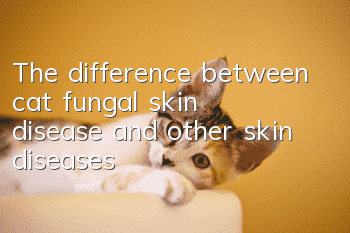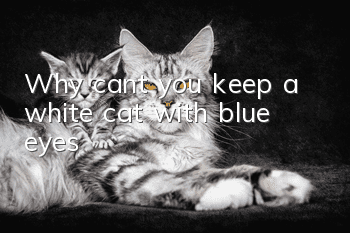The difference between cat fungal skin disease and other skin diseases

Cat skin diseases often trouble us, and there are many causes of cat skin diseases, such as fungi, bacteria, parasitic infections or allergies, etc. Fungal skin diseases are common, such as cat moss, and cat moss is also a common cause. This type of disease can be transmitted between humans and cats, so special attention should be paid to prevention and control. The treatment of fungal skin diseases after the onset is also a big problem. Some cats recover after treatment but relapse after a period of time. This requires some improvements in treatment methods and medications.
1. What is the difference between cat fungal skin diseases and other skin diseases?
Since the symptoms of this disease are similar to those of staphylococcal folliculitis and demodicosis, the following methods can be used for diagnosis. Woodlight examination (also known as filtered ultraviolet examination): Use Woodlight lamp to illuminate the lesion area, hair loss or dander in a dark room. Hair infected by Microsporum spores can fluoresce apple-green, while hair infected by Microsporum gypsum and Trichophyton mentagrophytes has no fluorescence or is a different color.
Or check the hair, pluck the hair from the inflammatory site or take the broken hair or the fluorescent hair under the Wooden lamp, place it on a glass slide, add a few drops of 10%~20% KOH and add a cover slip. Act for 30 minutes or heat slightly for 15 seconds. After the sample is transparent, check for fungal spores or hyphae.
Fungal culture can also be used. Hair and other diseased materials can be inoculated on dermatophyte test medium or Sabouraud medium, and cultured in 25R2. The DTM will turn red during the growth of dermatophytes, or according to the growth of dermatophyte on Sabouraud medium Colonies were identified by color and morphology and microscopic examination.
2. Precautions in the treatment of fungal skin diseases
Generally, for fungal skin diseases, you need to cut off the hair on the affected area first, then apply antifungal ointment. In severe cases, you need to take a bath with medicine. At the same time, Ketocon tablets, griseofulvin tablets, etc. can be taken orally. During the period of taking the medicine, it is best to supplement vitamins and feed more fatty foods instead of alkaline foods such as milk.
In the treatment, it must be "thorough", otherwise the skin disease will recur. Pay attention to the following points, and it will be much better:
1) It is best to remove all the wooden furniture in the cage, expose it to the sun, do not use it for now, and then put it back when it is completely healed. Because if fungi get on wood products, they can survive for a long time and form new vectors of infection.
2) Wipe the cage with 75% alcohol every day to allow it to evaporate naturally and disinfect.
3) Every time you apply medicine, carefully blow open all parts of the body. If you find new lesions, apply medicine immediately.
4) When applying the medicine, try to expand the area and moisten the joint between the bald spot and the fine hair.
5) After applying the medicine, fine hairs appear on the top, but usually fine hairs appear in the middle of the bald spot, but the surrounding area is still bald, and the surrounding area is still contagious., so the bald area around it must continue to be treated with medicine until fine hair appears. Only then will the bald spot be completely healed and lose its contagiousness.
6) Keep the indoors cool and dry. Humidity and heat are a paradise for fungi to thrive. In this way, "one after another" situations can be minimized.
- What symptoms will occur if a cat eats hair removal cream? Are there any side effects?
- Why does my cat have soft stool?
- Will adult cats recognize their owners?
- Preventive measures for cat skin diseases in summer
- Can cats eat green peas?
- What's the impact if a cat's tail is cut off?
- What to do if a cat has dystocia
- Cat's back muscles occasionally twitch
- How long can a cat live with weakness in its abdominal and hind legs?
- Can Deluxe milk be fed to cats?



